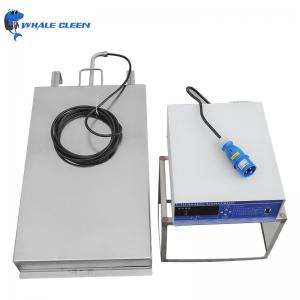

Add to Cart
Submersible Ultrasonics Cleaners With 2400W Ultrasonic Power For Passivation Tank
Common Applications – Advantages of Immersible Ultrasonic Cleaning Transducers
Drop in ultrasonics to existing manufacturing cleaning process
lines, such as aqueous cleaning lines, passivation, plating lines,
or other part finishing processes which require microscopic surface
scrubbing agitation.
The heavy-duty design of the stainless-steel box has completely
sealed components, which allows for precision ultrasonic cleaning
in conditions normally too harsh for such precision electronics.
Valve bodies and manifolds with small internals not accessible for
cleaning by forced spray or mechanical removal.
Medical device stainless steel parts cleaning.
Aerospace parts cleaning.
Ultrasonic part cleaning of water soluble machining coolants,
chips, particulate, and true machining/cutting oils, buffing,
polishing and lapping compounds which require mechanical surface
scrubbing to remove.
General washing for maintenance, manufacturing, rework and/or
remanufacturing.
Common Configurations
Since submersible ultrasonic boxes are most commonly added to
existing stainless steel and other metallic based tanks, the boxes
and ultrasonic power are made to fit such tanks. We can easily make
our immersible ultrasonic cleaning transducers into any tank
configuration sizing required for your application with little to
no additional custom size pricing.
Any tank can become an ultrasonic cleaning tank with Kaijo’s drop-in Immersible Ultrasonic Transducer. Made from highly polished 316L stainless-steel, these transducers may be used with any model Kaijo generator. The transducer assembly is hermetically seal welded with a stainless steel back cover. This ensures the water-tight submersible ultrasonic transducer that will reliably operate in any cleaning tank.
How Ultrasonic Cleaner Work?
Ultrasonic cleaning is a process that uses ultrasound (usually from
20–400KHz) to agitate a fluid. The ultrasound can be used with just
water, but use of a solvent appropriate for the item to be cleaned
and the type of soiling present enhances the effect. Cleaning
normally lasts between three and six minutes, but can also exceed
20 minutes, depending on the object to be cleaned.
Ultrasonic cleaners are used to clean many different types of
objects, including jewelry, lenses and other optical parts,
watches, dental and surgical instruments, tools coins, fountain
pens, golf clubs, fishing reels, window blinds, firearms, car fuel
injector, musical instruments, gramophone records, industrial parts
and electronic equipment. They are used in many jewelry workshops,
watchmakers' establishments, and electronic repair workshops.
The Comparison Of Ultrasonic Cleaning And Traditional Cleaning:
| Comparing Item | Traditional Cleaning | Ultrasonic Cleaning |
| Cleaning Time | Slower | Faster |
| Safety Level | Low | High |
| Labor Cost | High | Nearly Zero Labor Cost |
| Harmful Level | Sometimes It Will Be Harmful | Nearly Zero Harm |
Application:
| Industry | Cleaning Objects |
| Auto industry | engine parts, gear box, shock absorber, auto nozzle, cylinder, valve, Carburetors |
| Electrnoincs | PCB board, electronic parts, TV parts, computer parts |
| Aerospace and marine parts | Turbine blades, Marine Engine components, Overhaul parts, Pneumatics |
| Machinery | Moulds, precision parts, pressing parts, camera parts, bearing, hardware tools |
| Plating and Painting | polishing parts, SUS cutter, tableware, plating |
| Food industry | Oven tray, boiler, bottles, bottle cap, Hood Filters |
| Optical& watch tool | optical lens, eyeglass, sunglass, metal, gold, jewelry, diamond, watch band, watch cover, watch hand |
| Jewelry | Jewelry, diamond, gold, silver products |
| Dental and Medical | Dental Device, Medical Implant, beakers, bottles, vials, pipettes,
or other labware. |
How Ultrasonic Cleaner Work?
Ultrasonic cleaner is working through a vibration over 20KHz. When
the vibration transfers to cleaning liquid, it will generate
millions of bubble and these bubbles will break in very short time.
It will generate huge pressure in this process. We call it
cavitation. The pressure will take away the contaminant on cleaning
parts.
Cleaning Effect:
FAQ:
What are the advantages of ultrasound over traditional cleaning
methods?
minimize the use of manual labor
make cleaning and degreasing without the use of organic solvents
clean hard to reach areas of products and remove all types of dirt
shorten the processes such as extraction, dispersion, purification,
chemical reactions
eliminates costly mechanical and chemical cleaning of heat
exchangers
